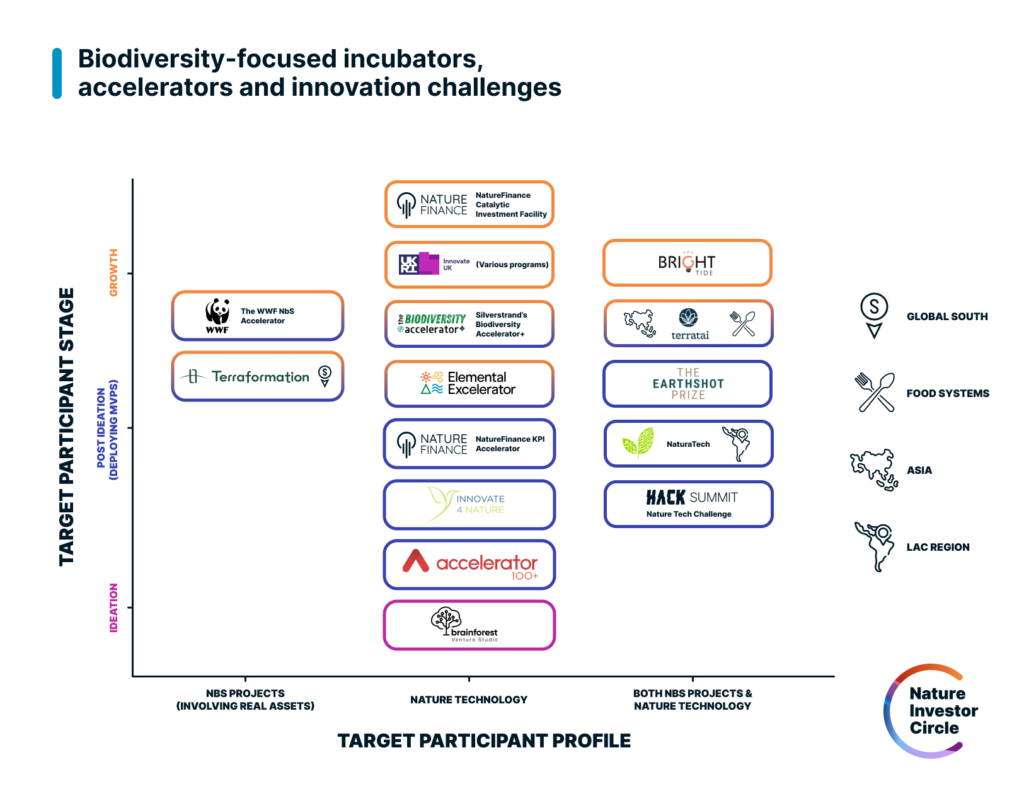In recent years, the emerging fields of nature markets and NatureTech have captured the attention of entrepreneurs and investors worldwide.
These fields, which help us to finance, understand, and restore nature, are clearly complex, and widely acknowledged to represent circumstances beyond business-as-usual.
Nature-positive ventures need to grow to reach financial sustainability, but they also must align with broader environmental and socio-economic goals to effectively provide solutions for the transition to a nature-positive net-zero economy. While the policy and regulatory environment is evolving, generic playbooks for growth and investment aren’t enough to meet and balance these objectives.
In this context, how can investors and capacity builders understand market opportunities and challenges to support ventures successfully? And for entrepreneurs and business-builders, how should they leverage the current ecosystem landscape to help scale their businesses?
Market Opportunities and Challenges
To understand how investors and capacity builders can best support and grow nature-positive ventures, we must unpack the specific set of opportunities and challenges faced by nature companies and projects. We present these together, because oftentimes, the opportunity set can become a double-edged sword, if not well managed.
Navigating the policy environment: There are several developing nature-related policies worldwide (e.g. EU Nature Restoration Law) that are expected to drive demand for nature-positive solutions. These can certainly provide an enabling environment for startups and nature-based solutions to grow their sales. However, relying too heavily on policy to drive revenues can also pose a risk to businesses. Given the emerging landscape, policy-dependent demand can fluctuate drastically, completely beyond the control of the enterprise. Developing revenue streams not solely reliant on policy is an important part of the strategy. For example, developing products that can be used for multiple use cases (i.e. bio-data to be used in nature disclosures and the insurance sector) could provide some optionality. On the other hand, the uncertainty surrounding nature policies can also be turned into an opportunity, for nature-positive companies to raise the bar in the quality of solutions and tools as well as for ventures to conduct market advocacy through providing compelling evidence and data for proposed changes, driving high-quality policy development and implementation. An example of this could be through developing high-integrity metrics for biodiversity.
Excitement and uncertainty in voluntary disclosures & nature markets: Despite excitement around the potential of voluntary nature markets (e.g. biodiversity credits) and voluntary nature disclosures (e.g. TNFD), skepticism remains around the real end-user demand and customer acceptance. Many are sensing there is still a lot of education and capacity building that must happen within corporates. Without a clear demand in the market, establishing robust business models can be extremely challenging. This space will require significant bottom-up action from corporates in leading insetting strategies for value/ supply chains that can trickle up to scale nationally and internationally. Excitement has been bolstered by the introduction of frameworks such as the Task Force for Nature-related Disclosures, which had 320 early adopters representing US$4 trillion in market capitalization. In response to these trends, many ventures have developed tools for monitoring, reporting, and verifying (MRV) the environmental impact of nature-based solutions and corporate operations – The TNFD Tools Catalogue lists hundreds of options to choose from.
Balancing scientific rigor, accessibility and customer needs: Today, the market is saturated with several nature standards, metrics, and methodologies. Despite this, we are still lacking a broadly accepted norm. No longer operating within the parameters of academia and scientific literature alone, ventures must: 1) find the ideal point where rigor and accessibility meet, and 2) unpack their role in the ecosystem – whether they want to become methodology developers and standard setters, or tool providers. The teams that can do this successfully, with the right mix of skill sets in their teams, will be able to differentiate themselves in the market.
Building demand through industry partnerships: Within a fragmented market landscape it could be beneficial to forge value-chain partnerships that bring a holistic solution to end users. For example, ERM, Salesforce, NatureMetrics and Planet have combined forces to form a new initiative to help companies tackle urgent biodiversity challenges. Their alliance will focus on biodiversity measurement, management and disclosure, supporting businesses to get ahead of their nature impact reporting commitments. Given the difficulties for one venture alone to offer a holistic service to the market, such partnerships can help to trial-and-error market products more effectively.
Not one size fits all: A number of nature projects and ventures may require high capital investment. Whether in AI development or engineering peatlands to rewet them, specific nature-related businesses often cannot escape their high upfront costs. On the other side of the coin, they can also be exposed to tangible risks intrinsic to operating in the physical world, such as the risk of climatic events destroying reforestation efforts. Venture-style financing models don’t always fit well into these dynamics. Founders must seek the right funding models that recognize their non-financial value, and that are appropriate to their risk and reward profiles. For example, certain ventures might prefer to position themselves as long-term infrastructure projects, to find financing options that take on development risk to render them shovel ready. There is an opportunity here for innovation, even in financing structure, and founders should be clear about which types of funders and capacity builders might be best suited to address their business’ needs.
A growing supportive ecosystem
While the ecosystem is still young, there is a small but growing number of biodiversity-focused incubators, accelerators, venture builders, and innovation challenges that seek to support nature-positive ventures to navigate the above challenges and opportunities.
As discussed, different company profiles require tailored capacity-building. For example, some may better suit companies seeking to grow quickly and raise funds using equity, while others, such as real asset-based businesses, may better suit more patient forms of capital including debt. Below, we present a selection of players in the landscape, based on the stage of growth they hope to serve, and the type of nature businesses (and sometimes non-profits) they support.

Broadly speaking, these capacity building initiatives seek to contribute to the ecosystem in some combination of the following:
Core Business & Ethical Fundamentals: Many early-stage ventures require foundational support to establish robust business practices. This often involves enhancing governance structures, improving financial management, recruiting for key strategic roles, and resolving legal or tax issues. While these challenges are common for startups, they tend to be more acute in nature-positive ventures, as many founders are first-timers with limited business experience. Equally, the fundamental ethical strategy of the business is paramount, to ensure a positive contribution to the ecosystem. Ventures must start putting at the core of their business practices the question of ‘how’ they will produce nature-positive and equitable outcomes while considering their systemic consequences on nature and the economy.
Creating strong market strategies: From formulating a go-to-market plan to gaining confidence in product/marketing fit, for all ventures, creating a clear market strategy will be critical. This is often an area of struggle even for nature positive-focused founders due to the nascency of the markets and the diversity of potential paths that can be taken. Nature positive-focused incubators, venture builders and accelerators often attempt to help founders understand when to lean on policy in their business models, when to seek external opportunities in the market, and how to choose customer segments and pricing models.
Becoming “investment-ready” for the appropriate financing tool: Capacity builders can help their portfolios create a strategy to target the right blend of financing, whether that’s catalytic grant funding, debt, equity, or first-of-a-kind financing tools like Elemental Excelerator’s D-SAFE. Additionally, capacity builders can help with considering other parameters. This can include time horizons, alignment with mandate/ mission and patient development to identify a variety of funder types (e.g. family offices, philanthropy etc.).
Building an enabling ecosystem with industry & cross-sector partnerships: Establishing collaborations with key partners can lend credibility to innovations, open new market opportunities, and ensure ventures are building products and services that customers want and which are needed for equitable nature markets. Many capacity builders bring together an enabling ecosystem for their cohorts, including academia, government, philanthropy, industry and local communities – which all play a pivotal role in nature markets. We see interesting examples already of these collaborations including. Natwest partnering with Innovate UK Business Connect and the Satellite Applications Catapult to enable space and finance companies to come together to build solutions for nature-based solutions.
Unlocking market premiums by demonstrating impact clearly: Building optionality in one’s business model can yield higher premiums in the market. Using nature and carbon credits as examples, those that include proven socio-economic benefits can often ask for higher prices to justify the impact “return”. “Credits from projects with at least one co-benefit certification had a 78% price premium compared to projects without any co-benefit certification”. In these cases, however, it is essential to have clear ways to measure impact in order to increase accountability and avoid greenwashing. Designing nature markets is a complex problem, and capacity builders can help products create strong impact policies and demonstrate more than one distinctive benefit.
Conclusions
While there is no silver bullet to address the biodiversity crisis, creativity and collaboration are two essential components needed to build hybrid profit models that emphasize the public and social good.
There is a strong community of practitioners across sectors and geographies, who work to develop offerings that capitalize on emerging opportunities to create solutions to mitigate nature loss and support communities. Different hybrids of business, pricing, and funding models are necessary, built based on the unique circumstances of the specific driver of biodiversity loss that is being addressed – from habitat loss to pollution, from climate change to invasive species.
Given the vibrancy of nature markets, and to better forge the path ahead, key questions must be asked. For entrepreneurs, what are your greatest pain points, and which programme is best designed to provide the most appropriate support? What perspectives do you lack and need guidance on? Are you ensuring the development of a high-integrity solution that is setting a positive precedent in the market? For capacity builders, what are your team’s skill sets? What are the innovations you can build in the cap stack and how can you bring different types of investors on the table? What experience do you have that would benefit the ecosystem best? And what are the gaps in the ecosystem that you are well positioned to fill – how can you be additional?
To collectively contribute to a nature-rich and equitable economy, we invite both innovators and capacity builders to engage in the ecosystem and ask some of the important questions outlined above.
Co-authored by Kostantina Koulouri (NatureFinance), Yuni Choi (Terratai), and Rachel Ashton Lim (Silverstrand).



